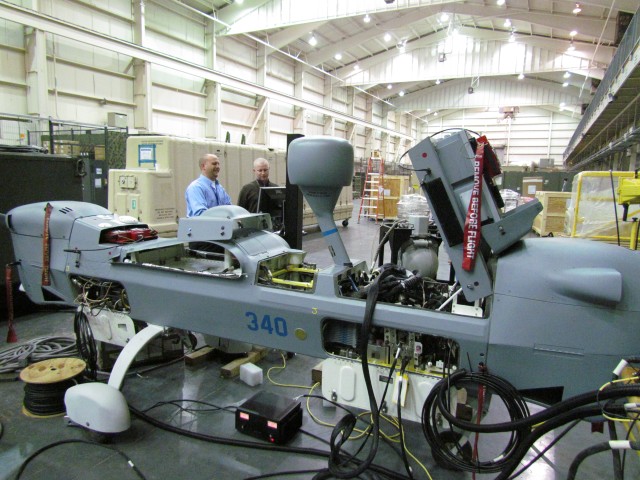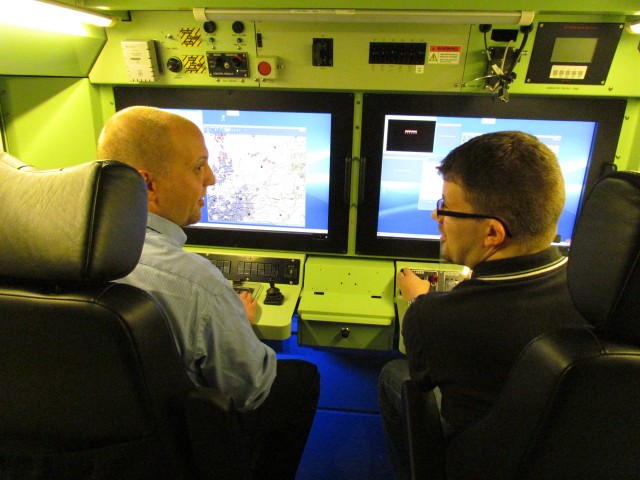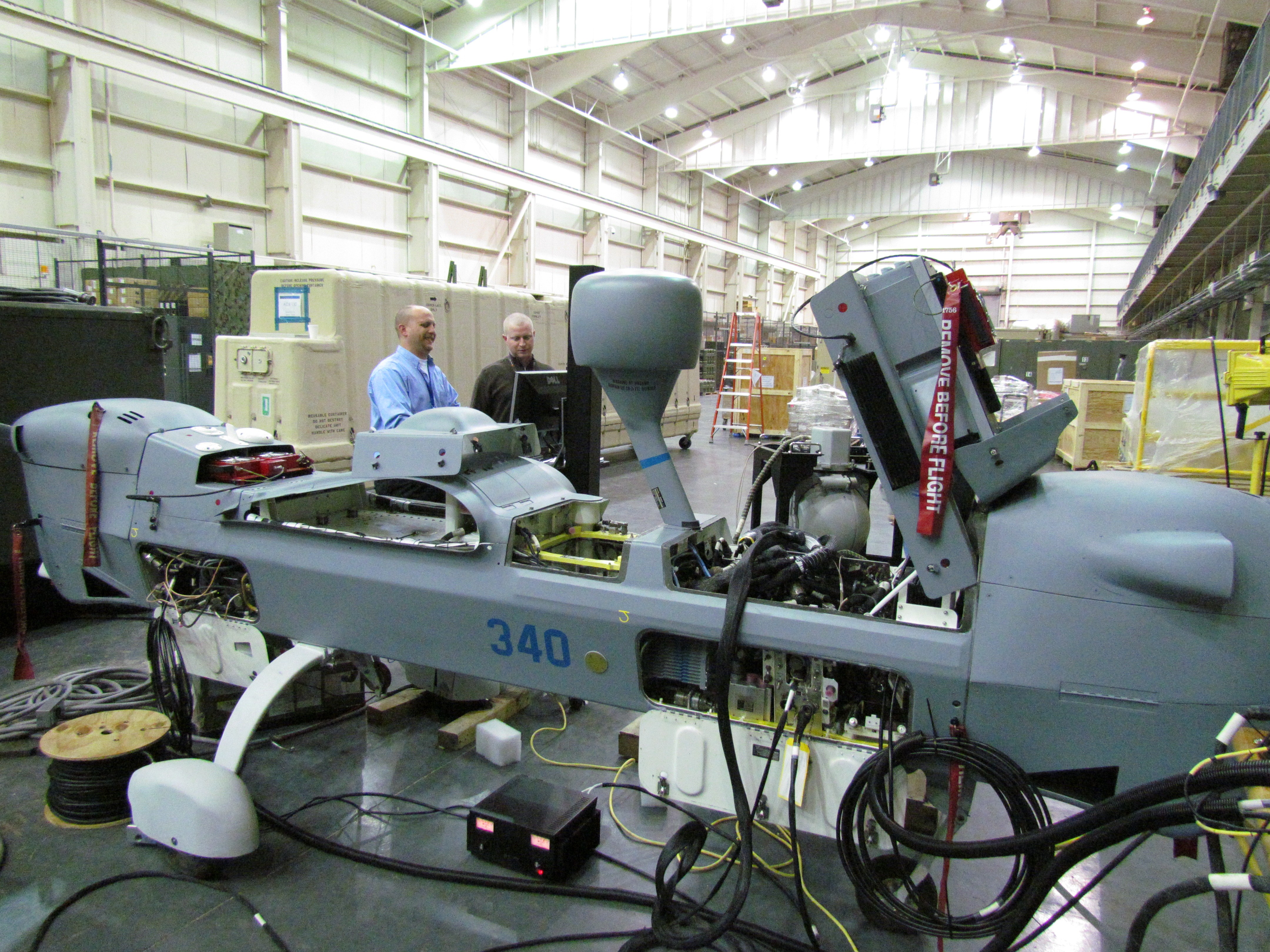REDSTONE ARSENAL, Ala.--Just the other day, the Gray Eagle was flying 8,000 feet above Hazel Green.
Well, not actually.
The flight was simulated.
Cables and computers connected to a 28-foot-long Gray Eagle stationed in a high-bay area of the Software Engineering Directorate collected data as the unmanned aircraft flew a simulated flight across North Alabama. Engineers tracked its progress on ground control stations, much like what Soldiers would actually do if they were operating the unmanned aircraft in theater.
Employees working for SED and the Unmanned Aircraft Systems Project Office are setting up a simulation lab that will test the capabilities of three unmanned aircraft - the Gray Eagle, Hunter and Shadow -- that will be the star players in a real-life simulation of unmanned and manned aircraft at Dugway Proving Ground, Utah, on Sept. 16. The real-life test, which will team these unmanned systems along with the Puma and Raven unmanned aircraft in working scenarios with Kiowa and Apache helicopters, is known as the MUSIC exercise, or Manned/Unmanned System Integration Capability exercise.
"We are working to manage all the interoperability between manned and unmanned systems," said Lt. Col. Jennifer Jensen, product manager for Common Systems Integration, Unmanned Aircraft Systems Project Office.
"This will be the first time we're showing this interoperability in real-life. Some have worked together during deployments. Some have not. This will be the first time we are getting all these systems together in one location."
MUSIC will be outlined to participants in the annual Pathfinder Symposium for the Association for Unmanned Vehicle Systems International, which is set for today and Thursday at the Von Braun Center.
In the early days of unmanned aircraft, industry designed and developed the unmanned aircraft systems that the Army then acquired and fielded. Though the effort put some of the best capabilities in the field to provide Soldiers with improved situational awareness, they were designed with different platforms that are not interoperable.
"The Office of the Secretary of Defense and the Department of Defense created standards to make the systems interoperable," Jensen said. "But each company interpreted those standards in a different way and their systems became proprietary.
"Five years ago, we got together with industry partners to talk about how we can implement Army standards for interoperability. We created interoperability profiles, and addressed how information would flow and how the systems would interface."
The effort led to the development of common formats, networks, and command and control so that different unmanned aircraft could be operated from a single ground station, said Ed Gozdur, deputy project manager for Common Systems Integration.
"The culmination of our work is to develop these profiles that make the systems interoperable and then testing the systems in interoperable situations," Jensen said. "What we are doing is making these systems more efficient, effective and useful."
But before that reality test can take place at Dugway, several simulated tests will be done to reduce the risks of real-life test scenarios and to ensure that testing goals are achievable when the unmanned and manned aircraft share the same airspace. And that's where SED's Joint Service Integration Lab comes into play.
"Hardware-in-the-loop test is important to proving interoperability and to reducing risk in the actual test," said Michelle Vigo, deputy for planning and execution of MUSIC.
"The tests we are doing in the JSIL and then at Dugway will show for the first time that one universal ground control station can control three different airplanes (Gray Eagle, Hunter and Shadow). Now, we are using proprietary ground stations to control each aircraft. The universal ground control station is a huge transition from the proprietary ground control station."
Besides interoperability, MUSIC will also test the One System Remote Video Terminal that will allow operators to actually control the unmanned aircraft's camera so that it can command the aircraft's direction. The terminal will also allow operators to receive video from the smaller Raven and Puma unmanned aircraft.
"This will give Soldiers full control of the systems," Jensen said.
MUSIC will also demonstrate Manned-to-Unmanned Teaming, which allows the manned aircraft to access the view of unmanned aircraft while flying together in the airspace.
"This allows the Apache pilot to control the unmanned aircraft and its camera," Jensen said. "It extends the eyes of the helicopter pilot. Before, the pilot could only see with his eyes. Now, he can also see with the eyes of the unmanned aircraft."
And fourthly, MUSIC will demonstrate the use of Mini-Universal Ground Control Stations to control the smaller Raven and Puma unmanned aircraft.
"There are different levels of interoperability that we can do through the ground stations," Vigo said. "There's direct receipt of video from the unmanned aircraft. There's payload - or camera - control of the unmanned aircraft. There's universal control of the unmanned aircraft except for takeoff and landing. And then there is control of everything, including takeoff and landing."
Although MUSIC doesn't occur until September, hardware is now being set up in the JSIL to do all the simulated testing, which will begin in April and continue through June.
"We are bringing all the platforms in and integrating them in the lab," Vigo said. "During Phase 1, right now, SED is setting up the network infrastructure to do all the testing in the lab. During Phase 2, we are bringing in all the platforms (of Gray Eagle, Shadow and Hunter) for the testing. In Phase 3, the full-out testing will include an Apache simulator. In Phase 4, we will test out everything and then we will have a configuration lock down of all systems and software."
Then, four weeks before the September test, set up will begin at Dugway.
"The key to this entire exercise is it's the first time we've ever flown three different airframes from the same ground control station," Jensen said. "If we can prove this can be done, then we can have common training and common logistics for all the systems. This makes the systems more economical and puts more assets in the war fighter's hands."
MUSIC is also crucial to the future teaming of manned and unmanned aircraft. "We want to show they are able to work together on collaborative engagements," Jensen said.
"We want to expand capabilities to more platforms, take this effort across the Department of Defense and show other services how their systems can be interoperable."




Social Sharing